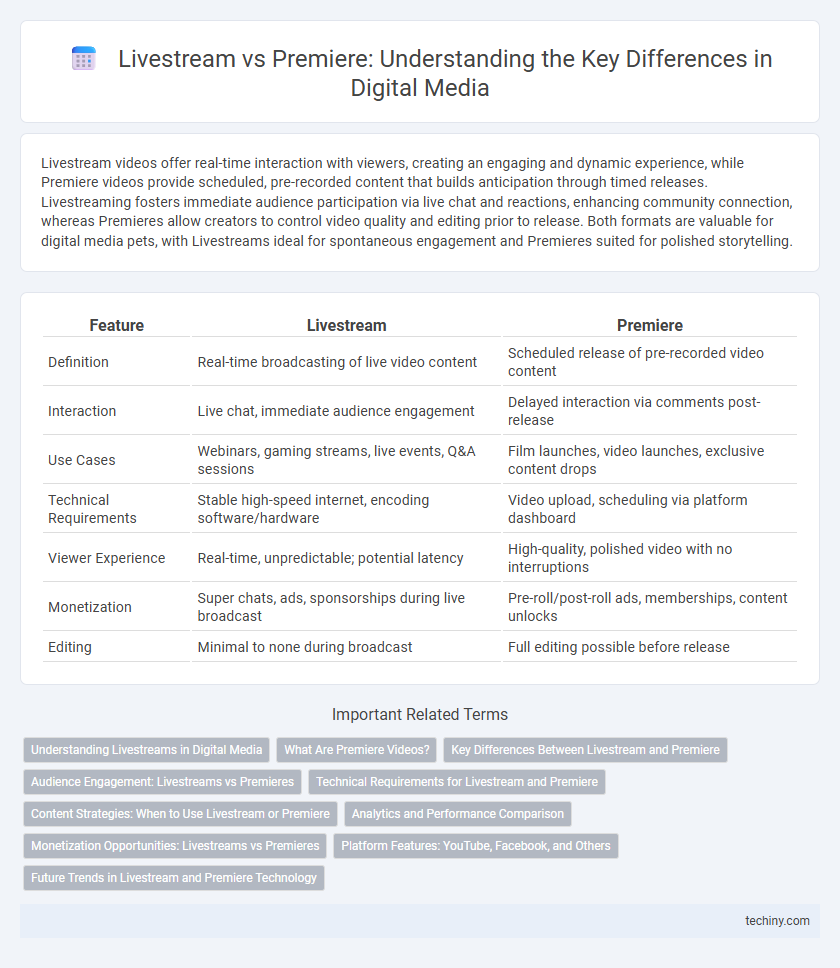Livestream videos offer real-time interaction with viewers, creating an engaging and dynamic experience, while Premiere videos provide scheduled, pre-recorded content that builds anticipation through timed releases. Livestreaming fosters immediate audience participation via live chat and reactions, enhancing community connection, whereas Premieres allow creators to control video quality and editing prior to release. Both formats are valuable for digital media pets, with Livestreams ideal for spontaneous engagement and Premieres suited for polished storytelling.
Table of Comparison
| Feature | Livestream | Premiere |
|---|---|---|
| Definition | Real-time broadcasting of live video content | Scheduled release of pre-recorded video content |
| Interaction | Live chat, immediate audience engagement | Delayed interaction via comments post-release |
| Use Cases | Webinars, gaming streams, live events, Q&A sessions | Film launches, video launches, exclusive content drops |
| Technical Requirements | Stable high-speed internet, encoding software/hardware | Video upload, scheduling via platform dashboard |
| Viewer Experience | Real-time, unpredictable; potential latency | High-quality, polished video with no interruptions |
| Monetization | Super chats, ads, sponsorships during live broadcast | Pre-roll/post-roll ads, memberships, content unlocks |
| Editing | Minimal to none during broadcast | Full editing possible before release |
Understanding Livestreams in Digital Media
Livestreams in digital media provide real-time interaction between content creators and audiences, enhancing viewer engagement through live chat features and instant feedback. Unlike premieres, which are pre-recorded videos scheduled for simultaneous viewing, livestreams offer spontaneity and dynamic content adaptation based on audience reactions. This immediate connectivity fosters community building and creates unique experiences that are highly valued in platforms like Twitch, YouTube Live, and Facebook Live.
What Are Premiere Videos?
Premiere videos are pre-recorded content scheduled for a specific release time on digital platforms, allowing creators to generate anticipation and engage viewers in real-time chat during the debut. Unlike livestreams, which broadcast content live as it happens, premieres provide the polish of edited video combined with the immediacy of live interaction. This format enhances viewer experience by combining the benefits of on-demand video and live engagement tools on platforms like YouTube and Facebook.
Key Differences Between Livestream and Premiere
Livestream offers real-time interaction with viewers, enabling immediate feedback and engagement, while Premiere involves pre-recorded content released at a scheduled time, emphasizing polished production quality. Livestream requires a stable internet connection for seamless broadcasting, whereas Premiere uploads content ahead, allowing for edits and post-production enhancements. The choice depends on whether the priority is spontaneous viewer interaction or controlled, high-quality presentation.
Audience Engagement: Livestreams vs Premieres
Livestreams foster real-time audience engagement by enabling viewers to interact instantly through chat, reactions, and Q&A features, creating a dynamic and participatory experience. Premieres, while offering scheduled viewing with a live chat element, lack the spontaneity of livestreams but still cultivate anticipation and community discussion around newly released content. Both formats boost viewer involvement, but livestreams drive higher direct interaction, enhancing emotional connection and content immediacy.
Technical Requirements for Livestream and Premiere
Livestream requires a stable high-speed internet connection, encoding software or hardware, and a compatible streaming platform to ensure real-time broadcast without latency issues. Premiere demands pre-recorded video files in supported formats, sufficient storage for editing, and a powerful computer with adequate CPU and GPU resources to handle rendering and post-production. Both methods necessitate quality audio input, but livestreaming prioritizes continuous upload bandwidth while Premiere emphasizes processing power and file system speed.
Content Strategies: When to Use Livestream or Premiere
Livestreams generate real-time engagement by fostering direct interaction and immediate feedback, making them ideal for product launches, Q&A sessions, and live events. Premieres are best used for pre-recorded content that benefits from scheduled releases and built-in hype, such as trailers, tutorials, or episodic series. Combining both can maximize audience reach by leveraging live spontaneity alongside polished, planned presentations.
Analytics and Performance Comparison
Livestream analytics provide real-time data on viewer engagement, including concurrent viewership, chat interactions, and drop-off rates, enabling immediate content optimization. Premiere analytics focus on post-event metrics such as total views, watch time, and audience retention patterns, providing insights into long-term performance. Comparing both, livestreams excel in dynamic engagement tracking, while premieres offer comprehensive aggregate data for strategic content evaluation.
Monetization Opportunities: Livestreams vs Premieres
Livestreams offer real-time viewer interaction, enabling direct monetization through super chats, donations, and memberships, which can boost immediate revenue. Premieres provide scheduled content releases that generate anticipation, maximizing upfront ad revenue and increasing watch time, enhancing long-term monetization. Both formats integrate YouTube's ad system, but livestreams often generate higher engagement-driven income, whereas premieres optimize advertiser exposure through consistent audience retention.
Platform Features: YouTube, Facebook, and Others
YouTube offers Livestream with real-time interaction through live chat and super chat monetization, while Premiere provides scheduled video releases with timed comments and countdowns, enhancing viewer anticipation. Facebook supports Livestream with interactive reactions, polls, and real-time sharing, whereas Premiere allows creators to debut pre-recorded videos with synchronized chat, fostering community engagement without live broadcasting pressure. Other platforms like Twitch and Instagram emphasize Livestream with features such as donations, emotes, and story integration, but generally lack dedicated Premiere options, focusing on immediacy and spontaneous audience engagement.
Future Trends in Livestream and Premiere Technology
Livestream technology is advancing with improved low-latency streaming, interactive features, and AI-driven content personalization, enabling real-time audience engagement and immersive experiences. Premiere technology is evolving through enhanced pre-recorded content editing tools, seamless integration with AI for automated scene optimization, and adaptive video quality for diverse viewing environments. Future trends indicate a convergence where livestreams will incorporate premiere-quality production value, leveraging 5G and cloud-based platforms to offer hybrid viewing options.
Livestream vs Premiere Infographic

 techiny.com
techiny.com